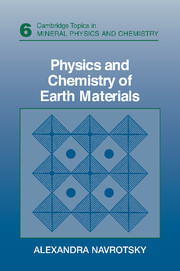Book contents
- Frontmatter
- Contents
- Acknowledgments
- 1 Introduction
- 2 Crystal chemistry
- 3 Experimental methods for studying structure
- 4 Methods for studying thermodynamic properties
- 5 Chemical bonding
- 6 Mineral thermodynamics
- 7 Solid solutions and order–disorder
- 8 Melts, glasses, and amorphous materials
- 9 The interface between mineral physics and materials science
- Index
2 - Crystal chemistry
Published online by Cambridge University Press: 05 June 2012
- Frontmatter
- Contents
- Acknowledgments
- 1 Introduction
- 2 Crystal chemistry
- 3 Experimental methods for studying structure
- 4 Methods for studying thermodynamic properties
- 5 Chemical bonding
- 6 Mineral thermodynamics
- 7 Solid solutions and order–disorder
- 8 Melts, glasses, and amorphous materials
- 9 The interface between mineral physics and materials science
- Index
Summary
Crystals: real and idealized
Physically, a crystal is an object of finite size containing various impurities and imperfections but adhering to an approximately regular arrangement of fundamental units (atoms, molecules, or ions). These units undergo vibrations about their equilibrium positions, the magnitude of which increases with increasing temperature. Mathematically, a lattice is an infinite space-filling construct adhering to certain operations that relate equivalent points. These operations are described in terms of symmetry elements about a point (rotations and reflections) that define a point group and symmetry operations involving movement along a vector (translations, glides, and screws) that, together with the point symmetry, define a space group. Because of its almost perfect periodicity, a real crystal can have associated with it a lattice that describes its symmetry or, more precisely, describes what the symmetry of a perfect crystal would be. The actual arrangement of atoms in the crystal, subject to the symmetry constraints of the lattice, is the crystal structure. A given space group or lattice can accommodate many different configurations of points corresponding to different atomic arrangements and therefore to distinct crystal structures. Both the idealized perfect crystal structure and deviations from that perfection (defects, disorder, interfaces) are of immense fundamental and practical importance.
Symmetry, space groups, and lattices
Symmetry about a point can be described in terms of rotations and mirror planes. An n-fold rotation is one of 360/n degrees (n an integer), where n such rotations are required to bring the object back to its original position.
- Type
- Chapter
- Information
- Physics and Chemistry of Earth Materials , pp. 7 - 90Publisher: Cambridge University PressPrint publication year: 1994
- 1
- Cited by



